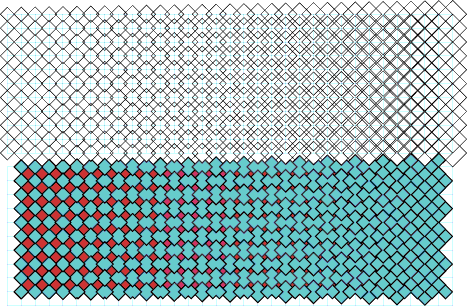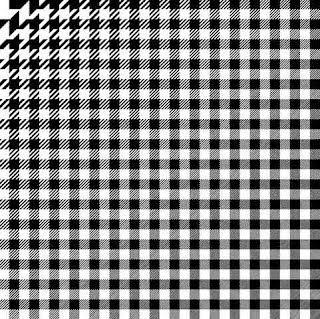Other People Below is a compilation, in chronological order, from other people’s parquet deformations of some note. Do any readers have examples of their own suitable for inclusion? If so, do send them to me! Although not strictly necessary, some background detail as to the creation would add to the story. c. 1964, David Oleson As discussed above, parquet deformations are usually shown simply, in one-dimension. However, it is indeed possible to have two dimensions. Indeed, this perhaps next stage in development was realised early on, at the time of Huff’s student-inspired creations, in the early 1960s. Quite who first thought of the concept is unclear. Did Huff suggest this? Was it a student-led initiative? Whatever, at least two of his students, David Oleson and Roland Findlay, show such instances, with Oleson’s I at the Center, dated 1964, with Findlay’s non-titled work not dated. Oleson’s work is the more widely known, discussed in depth and appearing in Douglas Hofstadter, whilst Findlay less so, only of a local newspaper article, and so here I thus concentrate on Oleson as the founder, rightly or wrongly in terms of priority. At the centre of his deformation is the capital letter I, from which the deformation in effect starts, and of which seen at the extremities of the square format the underlying shape remains. Such two-dimensional concept can be said to have ‘added value’, although this is not to denigrate the one dimension type; all are of merit. Indeed, the variation, or novelty, call it what you will, appears to have attracted the attention of others, with at least three discussions on Oleson’s work. Douglas Hofstadter, Tuğrul Yazar and Richard Plender have all written on Oleson’s work in relative depth, all seeing some additional meaning to this. Indeed, Hofstadter describes this instance as a favourite of his. Oleson later went on to become a well-known architect. He is the only ex-student of Huff whose contact detail I have been able to find, but disappointingly did not respond to an email as to further details of his design. c. 1990–2001+, John Sharp John Sharp (?–2020), of the UK, a prominent mathematician, with an leaning towards geometry and mathematical art, has, in a series of four blog postings (from 2010, see links below), shown both his own parquet deformations (of which he uses the alternative term ‘morphing’), numbered 1–12, as well as having a tutorial intent. These are all of the classic Huff-type, without any degree of complexity as evinced by Craig Kaplan’s more advanced work, but as discussed above, this is an observation rather than a criticism. A further page discusses deformations with an Islamic theme as a subpart of an Islamic tiling discussion. Of the numbered instances, both one- and two-dimension types are shown. Perhaps the best, of a two-dimension type, is that of No. 4, which has undoubted elegance. Further, the download page is a good source for ideas.
1998, Alvy Ray Smith and Norman Courtney Alvy Ray Smith (1943–) and Norman Courtney (1947–2017), both of the US, have, between them, created a most interesting parquet deformation, of a public artwork, titled Nagare, which is Japanese for flow. More specifically, Smith designed the deformation, whilst his friend Courtney executed the work, in glass. Each tile is roughly a slab of glass an inch thick or so and four inches or so across. This work is installed in Centennial Center lobby, Kent, and was commissioned by the City of Kent, Seattle, Washington in 1998. The Japanese background to this, taken from Courtney’s site is as follows: The City of Kent lies in the middle of the Green River valley, which is reported to be the richest farmland in the state of Washington. Before World War II it was primarily occupied by small Japanese-American truck farms that sold their produce in the Seattle Public Market and now is mostly filled up with large retail buildings and warehouses. The installation is meant to be a reference to that history as well as a place of beauty and elegance in the midst of the busy goings on of the city administrative offices. Further, Courtney was married to a Japanese woman and loved things Japanese. The notion of combining the folding screen with the parquet deformation idea came from that influence. And the name, of course. Both men, particularly Smith, have distinguished artistic backgrounds. Smith is well known as an early pioneer in computer graphics, and is a household name in the field, with too many honours to mention. Courtney was a leading light in the Seattle glass scene. Upon latterly (2018) following this up, Smith told me that he was a long-time fan of tiling, reading Grünbaum and Shephard’s classic book Tilings and Patterns. He wrote his PhD dissertation on CA (cellular automata theory) and became fascinated with tilings as a spin-off from that undertaking. However, possibly this is an adaptation of someone else’s design, as Smith told me didn’t recall inventing one himself. Plausibly, this is from the Hofstadter article. c. 2009, Daniel Piker Daniel Piker (1982– ) of the UK/US, with a background in architecture, and software user expert, and with a leaning towards geometry and mathematical art, has, in a series of blog postings (from 2009), shows his own parquet deformations (of which he uses the term ‘morphing tessellation fields’).
2012+, Tugral Yazar Tuğrul Yazar, an architecture professor of Istanbul Bilgi University, Istanbul, Turkey, can be described as one of the leading lights in the field of parquet deformation research, albeit perhaps not quite in the league of Craig Kaplan’s more advanced algorithm concepts. But even so, he still brings to bear some advanced concepts on the design process. He has written extensively on the subject, online, on his ‘designcoding’ pages and in print. As such, he shares some similarities with William Huff, in that he sets his students design problems with parquet deformations (among other design matters). Links to a variety of pages, including the students' work, can be seen in the references. His favoured computer aid is Rhino and the plug-in Grasshopper (of which I know nothing about). Some of his instances can be seen to be based on my more simple instances, or at least act as a starting point. He also includes discussions on three of Huff’s student-inspired works, Crossover, Trifoliate and I at the Center.
2016+, Werner Van Hoeydonck Werner Van Hoeydonck (1969– ), an architecture professor of Vienna University of Technology, Austria (and with his own practice) with a recent interest in parquet deformation (2016), has compiled three instances, of the linear type, as well as writing on the topic (see references, with links). As such, he shares some similarities with William Huff, in that he sets his students design problems with parquet deformations (among other design matters). His favoured computer aid is Rhino and the plug-in Grasshopper (of which I know nothing about). These are very pleasing indeed in an aesthetic sense, and one can easily see from his writings and examples that he understands the concept. 2016+, Edmund Harriss Edmund Harriss, a mathematics professor with an interest in mathematical art, has shown an interest in the subject, albeit not to an all-encompassing degree as with other people here. Perhaps not unsurprisingly, his work in the field is of a more advanced nature, reflecting his interest in non-periodic tilings, of which he is an authority. Examples of his work can be seen at four elevator surrounds in Champions Hall at the University of Arkansas, USA, newly installed in 2017. This is created from four different non-periodic tilings, one in each corner, that morph into each other from left to right and from top to bottom, thus giving a two-dimensional deformation (although the concept is not new; see Oleson). These are based upon the Amman-Beeker, 10-fold Penrose tiling, 12-fold Socolar tiling and 14-fold substitution tiling. This is all admirably described and illustrated by Harriss in the video from his presentation at the 'Gathering 4 Gardner' (G4G), 2016. Also see the book with Alex Bellos (detailed in references) Snowflake Seashell Star where a single deformation of the above is shown, with likely Bellos title ‘De-four-mation’. 2018, Mamoun Sakkal Mamoun Sakkal, a Syrian artist and calligrapher, based in the US, has created a most interesting parquet deformation, albeit by ‘favoured chance’, as upon correspondence (July 2018) he was unaware of the premise! Rather, this was composed because of his interest in Islamic geometrical patterns, of which in an article [1], specifically on overlapping squares, p. 87, he briefly, in the course of his studies, inadvertently created a parquet deformation. This can be seen as both a wireframe, top, and a derivative, below. His instance is aesthetically most pleasing indeed, as upon viewing from left to right, beginning with a series of squares at 45°, the deformation passes through its life cycle, before ending the same as the start. This can be described as having a ‘natural’ life cycle, rather than a simple reverse unwinding mid point, which would have less merit. [1] Sakkal, Mamoun. ‘Intersecting squares: applied geometry in the architecture of Timurid Samarkind’. Journal of Mathematics and the Arts, 2018, Vol 12, Nos. 2-3, pp. 65-95. 2018, Douglas Blumeyer Douglas Blumeyer, a graduate from Stanford University, US, with many varied interests including computer science, also has an interest in tiling, and in particular that of houndstooth. Indeed, he can be described as one of the two (the other being Loe Feijs) leading lights in research on this. In the course of his studies, he has composed two parquet deformations, albeit unaware of the term at the time. These, naturally, reflect his interest in related fabric matters, with works (2018) titled ‘Houndsmorphosis’ and ‘Gingham-Chevron Continuum’. Both show considerable innovation, of which without a computer background would be near to impossible to create by hand. ‘Houndsmorphosis’ shows a spiral (not seen elsewhere), whilst ‘Gingham-Chevron Continuum’ is a two dimensional instance in which the transitions go from Houndstooth to Shepherd’s Check, to Gingham. Background details as to the latter (including an animation) are at: https://cmloegcmluin.wordpress.com/2016/03/08/gingham-herringbone-continuum/ |
Parquet Deformations >




